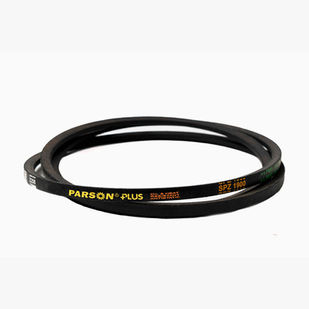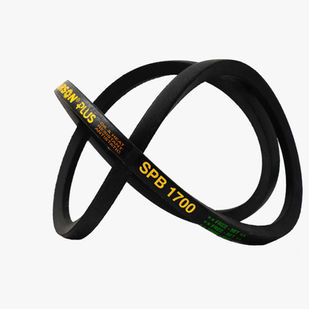Wedge Belts
Industrial wedge belts are a type of power transmission belt that is used in a wide variety of industrial applications. They are characterized by their wedge-shaped profile, which allows them to transmit high levels of power with a relatively small footprint. Industrial wedge belts are typically made from a variety of materials, including rubber, Kevlar, and polyester, and they are available in a variety of sizes and widths to accommodate a wide range of applications.

Applications & Benefits of Wedge Belts
Some of the most common applications for industrial wedge belts include:
-
Conveyor belts: Industrial wedge belts are often used in conveyor belts to transport materials from one location to another.
-
Pumps: Industrial wedge belts are also used in pumps to drive the impellers that move fluids.
-
Fans: Industrial wedge belts are also used in fans to drive the rotors that create airflow.
-
Machine tools: Industrial wedge belts are also used in machine tools to power the various components of the machines.
Industrial wedge belts are a versatile and reliable power transmission solution used in various industrial applications. They offer a number of advantages over other types of power transmission belts, including their high power transmission capacity, small footprint, and long lifespan.
Here are some benefits of using industrial wedge belts:
-
High power transmission capacity: Industrial wedge belts can transmit high levels of power with a relatively small footprint. This makes them ideal for applications where space is limited, such as in conveyor belts and pumps.
-
Small footprint: Industrial wedge belts have a small footprint, making them ideal for limited-space applications. This is in contrast to other types of power transmission belts, such as V-belts, which can be bulky and take up a lot of space.
-
Long lifespan: Industrial wedge belts have a long lifespan, which can save businesses money in the long run. This is because they do not need to be replaced as often as other types of power transmission belts.
If you are looking for a reliable and efficient power transmission solution for your industrial application, then industrial wedge belts are a great option. They offer a number of advantages over other types of power transmission belts, including their high power transmission capacity, small footprint, and long lifespan
V Belts
Industrial V belts are a type of power transmission belt that is used in a wide variety of applications, including:
-
Conveyor belts: V belts are commonly used in conveyor belts to transport materials.
-
Fan drives: V belts are used to drive fans in a variety of applications, such as air conditioning units and ventilation systems.
-
Pump drives: V belts are used to drive pumps in a variety of applications, such as water pumps and oil pumps.
-
Machine tools: V belts are used to drive machine tools, such as lathes and milling machines.
-
Other applications: V belts can also be used in a variety of other applications, such as lawnmowers, go-karts, and small engines.
V belts are made of a variety of materials, including rubber, polyester, and Kevlar. The type of material used will depend on the application. For example, V belts used in conveyor belts are typically made of rubber, while V belts used in machine tools are typically made of polyester or Kevlar.
V belts are available in a variety of sizes, lengths, and widths. The size of the V belt will depend on the power that needs to be transmitted. The length of the V belt will depend on the distance between the two pulleys. The width of the V belt will depend on the amount of torque that needs to be transmitted.
V belts are a reliable and efficient way to transmit power. They are easy to install and maintain, and they are available at a variety of prices.
Here are some of the advantages of using industrial V belts:
-
Reliable: V belts are a reliable way to transmit power. They are made of durable materials and are designed to withstand high loads.
-
Efficient: V belts are an efficient way to transmit power. They have a high power-to-weight ratio, which means that they can transmit a lot of power without being too heavy.
-
Easy to install: V belts are easy to install. They can be installed by anyone with basic mechanical skills.
-
Low-maintenance: V belts are low-maintenance. They do not require regular lubrication or adjustment.
If you are looking for a reliable, efficient, and easy-to-install way to transmit power, then industrial V belts are a great option.

Rubber Timing Belts
Industrial Rubber Timing Belts are durable, flexible, and precisely engineered belts designed to transmit power in a wide range of mechanical systems. They consist of a toothed belt made of high-quality rubber, which meshes with corresponding teeth on the pulleys to ensure accurate and synchronized power transmission.
These timing belts find extensive applications in numerous industries, including automotive, manufacturing, robotics, packaging, and more. They are commonly utilized in:
-
Automotive Industry: Timing belts are crucial components in internal combustion engines, ensuring the precise synchronization of camshafts, crankshafts, and other engine parts, leading to efficient and reliable performance.
-
Manufacturing and Automation: Industrial rubber timing belts are widely employed in manufacturing and assembly lines to synchronize the movement of different components and systems, enabling smooth operation and enhanced productivity.
-
Robotics: Timing belts play a vital role in robotic systems, facilitating precise motion control and synchronization of various robotic arms, axes, and mechanisms, thereby ensuring accurate and repeatable movements.
-
Packaging Industry: These belts are extensively used in packaging machinery for product handling, conveying, and positioning, ensuring precise timing and synchronization for efficient packaging operations.
-
Printing and Paper Industry: Timing belts are integral to printing presses, paper cutters, and folding machines, enabling precise control of paper movement, registration, and cutting processes.
-
Food Processing: Industrial rubber timing belts are employed in food processing equipment for conveying, sorting, and aligning products, ensuring synchronized movements in food production lines.

Ribbed Poly Belts
Industrial Ribbed Poly Belts, also known as poly-v belts or serpentine belts, feature a unique ribbed design on the inner surface. This design enables them to grip pulleys more effectively, providing superior power transmission and reducing slippage. The belts are made from high-quality polyurethane or polyester materials, ensuring durability and resistance to wear and tear.
These belts find wide-ranging applications across industries such as manufacturing, automotive, HVAC, agriculture, and more. Their versatility makes them suitable for use in various machinery and equipment, including conveyor systems, power tools, compressors, generators, and pumps.
One of the key advantages of Industrial Ribbed Poly Belts is their ability to handle high-speed and high-torque applications. The ribbed design allows for increased contact area with the pulley, enhancing power transmission efficiency. Moreover, their flexibility enables smooth operation and reduces vibrations, resulting in quieter performance and improved overall machinery functionality.
With excellent resistance to chemicals, oils, and extreme temperatures, Industrial Ribbed Poly Belts offer exceptional reliability even in harsh operating conditions. They require minimal maintenance, making them cost-effective and time-efficient solutions for industrial applications.

Cogged Belts
Industrial cogged belts, also known as V-belts or V-ribbed belts, are a type of power transmission belt widely used in various industries. They are constructed with a series of evenly spaced cogs or ribs on the inner side, which mesh with corresponding grooves on pulleys, providing efficient power transfer.
These belts are commonly made from rubber or synthetic materials, incorporating reinforcement layers for added strength and durability. The cogs or ribs on the belt's inner surface allow for better grip and increased surface contact with the pulleys, resulting in improved power transmission efficiency and reduced slippage compared to standard flat belts.
The applications of industrial cogged belts are diverse and found in a wide range of industries, including manufacturing, automotive, agriculture, mining, and more. They are commonly used for power transmission in various machinery and equipment, such as pumps, compressors, generators, HVAC systems, industrial fans, and conveyors.
The key advantages of industrial cogged belts include their ability to handle high-speed operations, transmit substantial power, and withstand demanding conditions, including temperature variations, moisture, and oil exposure. Their design also allows for compact and efficient drive systems, enabling space-saving installations.
In summary, industrial cogged belts are an essential component of power transmission systems, providing reliable and efficient power transfer in numerous industrial applications. Their unique design and durability make them a preferred choice for transmitting power and motion in various machinery and equipment across different industries.

Banded Belts
Industrial banded belts, also known as multiple V-belts or joined V-belts, are an essential component in various industrial applications where power transmission is required. These belts consist of two or more V-belts that are joined together with a strong, flexible band. The band effectively increases the power carrying capacity of the belts and provides enhanced stability and durability.
These belts are widely used in heavy-duty machinery and equipment, such as industrial pumps, compressors, generators, and conveyors. They are designed to handle high loads and demanding operating conditions. The banded structure allows the belts to distribute the load evenly across the multiple V-belts, minimizing stress on individual belts and maximizing power transfer efficiency.
The applications of industrial banded belts are diverse and can be found in various industries including manufacturing, mining, agriculture, construction, and automotive sectors. Some specific examples of their applications include:
-
HVAC Systems: Banded belts are used in heating, ventilation, and air conditioning (HVAC) systems to drive fans, blowers, and other components. They ensure reliable power transmission and smooth operation in maintaining indoor comfort.
-
Manufacturing Machinery: Industrial banded belts are utilized in manufacturing equipment, such as lathes, milling machines, and drill presses, to transmit power from motors to various tooling components. They enable precise and efficient machining processes.
-
Agricultural Equipment: Banded belts are commonly found in agricultural machinery like tractors, combines, and harvesters. They facilitate power transmission to drive essential functions, such as harvesting mechanisms, tillers, and grain augers.
-
Material Handling: Conveyors and elevators in warehouses, distribution centers, and factories rely on banded belts for the efficient movement of goods. These belts enable the smooth transfer of materials and packages over long distances and across different elevations.
-
Mining and Extraction: In the mining industry, industrial banded belts are used in heavy equipment like crushers, conveyors, and screens. They transmit power to break, transport, and separate minerals during the extraction process.
Overall, industrial banded belts play a crucial role in various applications by efficiently transmitting power, handling high loads, and ensuring reliable operation in demanding industrial environments.























